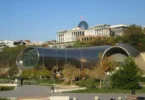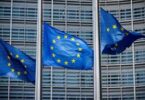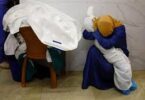Monitoring Desk
COLOMBO: The death toll in the coordinated bomb attacks in Sri Lanka has risen upwards to 290, a drastic increase from 207 reported previously, with the number of the wounded people at almost 500 now, police said early Monday morning.
A few hours earlier, it was reported that 207 people were killed and almost 450 injured in Sri Lanka when a string of blasts ripped through high-end hotels and churches as worshippers attended Easter services.
The powerful blasts — six in quick succession and then two more hours later — wrought devastation, including at the capital’s well-known St Anthony’s Shrine, a historic Catholic Church.
At least 500 were reported to be wounded in the attacks, including four Pakistani nationals.
Hospital sources said British, Dutch and American citizens were among the dead overall, with Britons and Japanese also injured. A Portuguese man also died, the country’s LUSA news agency reported.
An AFP photographer at the scene at St Anthony’s saw bodies lying on the floor, some draped with scarves and clothes.
Much of the church roof was blown out in the explosion, with roof tiles, glass and splintered wood littering the floor along with pools of blood.
The injured flooded into local hospitals, where officials reported hundreds of wounded were being admitted.
Sri Lankan security personnel keep watch outside the church premises following a blast at the St. Anthony´s Shrine in Kochchikade, Colombo on April 21, 2019. Photo: AFP
Sri Lankan security personnel keep watch outside the church premises following a blast at the St. Anthony´s Shrine in Kochchikade, Colombo on April 21, 2019. Photo: AFP
The nature of the blasts was not immediately clear and there were no immediate claims of responsibility.
President Maithripala Sirisena in an address said he was shocked by the explosions and appealed for calm.
Finance Minister Mangala Samaraweera, writing on his verified Twitter account, said the attacks had killed “many innocent people” and appeared to be a “well-coordinated attempt to create murder, mayhem & anarchy.”
The first explosions were reported at St Anthony’s Church in Colombo and St Sebastian’s in the town of Negombo just outside the capital.
Sri Lankan security personnel keep watch outside the church premises following a blast at the St. Anthony’s Shrine in Kochchikade, Colombo on April 21, 2019. Photo: AFP
“A bomb attack to our church, please come and help if your family members are there,” read a post in English on the church’s Facebook page.
Soon after, police confirmed that a third church in the east-coast town of Batticaloa had been hit, along with three high-end hotels in the capital.
Later in the afternoon, a hotel in the south of Colombo was struck — killing at least two people and bringing the toll to 158 — while another hit the suburb of Orugodawatta in the north of the capital.
The blasts hit the two churches as worshippers attended Easter services, police said.
Sri Lankan security personnel stand next to an ambulance outside St. Anthony’s Shrine in Kochchikade in Colombo on April 21, 2019, following a blast at the church. Photo: AFP
‘Cowardly attacks’
The hotels targeted in the attack are all popular destinations for tourists, among them the Cinnamon Grand, which is near the prime minister’s official residence in Colombo.
An official at the hotel told AFP the blast there had hit the restaurant, and reported at least one person had been killed.
At the Shangri-La hotel, an AFP photographer saw extensive damage on the second floor restaurant, with windows blown out and electrical wires hanging from the ceiling.
Sri Lankan Prime Minister Ranil Wickremesinghe condemned the attacks — the worst act of violence since the end of Sri Lanka’s civil war a decade ago — as “cowardly”, and said the government was working to “contain the situation”
“Emergency meeting called in a few minutes. Rescue operations underway,” Sri Lanka’s Minister of Economic Reforms and Public Distribution, Harsha de Silva, said in a tweet on his verified account.
He said he had been to two of the attacked hotels and was at the scene at St Anthony’s Shrine and described “horrible scenes.”
“I saw many body parts strewn all over,” he tweeted, adding that there were “many casualties including foreigners.”
“Please stay calm and indoors,” he added.
Photos circulating on social media showed the roof of one church had been almost blown off in the blast.
The floor was littered with a mixture of roof tiles, splintered wood and blood.
Several people could be seen covered in blood, with some trying to help those with more serious injuries.
Embassies in Colombo warned their citizens to shelter in place, and Sri Lankan Airlines told customers to arrive at the airport four hours ahead of flights because of ramped-up security in the wake of the attacks.
Police chief warning
Documents seen by AFP show that Sri Lanka’s police chief Pujuth Jayasundara issued an intelligence alert to top officers 10 days ago, warning that suicide bombers planned to hit “prominent churches”.
The defence ministry ordered a night-time curfew, beginning on Sunday 6pm local time (1230 GMT), and a “temporary” social media ban was imposed by the government.
‘Pakistan stands with Sri Lanka’
Prime Minister Imran Khan strongly condemned the attack and said Pakistan stands in complete solidarity with Sri Lanka in their hour of grief.
Courtesy: (AFP)
In just one church, St. Sebastian’s in Katuwapitiya, north of Colombo, more than 50 people had been killed, a police official told Reuters, with pictures showing bodies on the ground, blood on the pews and a destroyed roof.
Media reported 25 people were also killed in an attack on a church in Batticaloa in Eastern Province.
The three hotels hit were the Shangri-La Colombo, Kingsbury Hotel and Cinnamon Grand Colombo. It was unclear whether there were any casualties in the hotels.
Nine foreigners were among the dead, the officials said.
There were no immediate claims of responsibility for the attacks in a country which was at war for decades with Tamil separatists until 2009 during which bomb blasts in the capital were common.
Prime Minister Ranil Wickremesinghe called a national security council meeting at his home for later in the day.
One of the explosions was at St Anthony’s Church in Kochcikade, Colombo.
Our people are engaged in evacuating the casualties,” a source with the bomb squad said.
St. Sebastian’s church posted pictures of destruction inside the church on its Facebook page, showing blood on pews and the floor, and requested help from the public.
Last year, there were 86 verified incidents of discrimination, threats and violence against Christians, according to the National Christian Evangelical Alliance of Sri Lanka (NCEASL), which represents more than 200 churches and other Christian organizations.
This year, the NCEASL recorded 26 such incidents, including one in which Buddhist monks allegedly attempted to disrupt a Sunday worship service, with the last one reported on March 25.
Out of Sri Lanka’s total population of around 22 million, 70 percent are Buddhist, 12.6 percent Hindu, 9.7 percent Muslim, and 7.6 percent Christian, according to the country’s 2012 census.
In its 2018 report on Sri Lanka’s human rights, the U.S. State Department noted that some Christian groups and churches reported they had been pressured to end worship activities after authorities classified them as “unauthorised gatherings.”
The report also said Buddhist monks regularly tried to close down Christian and Muslim places of worship, citing unidentified sources.






